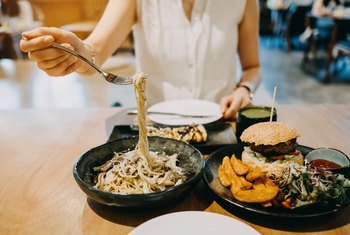Everything you eat is broken down and absorbed by the digestive system. Carbohydrate digestion occurs as soon as you begin chewing, and for some carbs it doesn't stop until you've excreted the waste of your meal. There are certain enzymes and hormones at work during carbohydrate digestion that are imperative for the proper breakdown and use of dietary carbohydrates.

image source
Mouth and Stomach
Digestion of carbohydrates begins inside the mouth. The salivary glands excrete an enzyme known as salivary amyalse that begins breaking down starches into oligosaccharides, or long chains of glucose molecules. Once food passes into the stomach, any salivary amylase that contacts the stomach acid is ineffective. However, if salivary amylase is protected from stomach acid because it is inside a food mass, its action can continue for 1 to 2 hours inside the stomach.
Small Intestine
Digestion of the remaining starchy carbs finishes in the small intestine. As the food mass enters the small intestine, it is greeted by two enzymes, dextrinase and glucoamylase that break down oligosaccharides. Maltose, a disaccharide, is broken down into glucose via the maltase enzyme. Sucrose, is broken down into fructose and glucose molecules by sucrase enzymes. Lactase, another disaccharide is split into glucose and galactose via the enzyme lactase. Digestion is through when all dietary carbohydrates are in their simplest forms: glucose, galactose and fructose.
Absorption
All simple carbohydrates are first taken up by the absorptive cells of the small intestine before they enter into the blood. Glucose and galactose enter the cell via the sodium-glucose transporter protein, or SGLT co-transporter mechanism. Glucose can also enter the cell through osmosis. Fructose enters the cell via a hexose transporter known as GLUT-5. Inside the cell, most simple carbs are converted into glucose. Glucose and the remaining fructose and galactose are then moved into the bloodstream via the GLUT-2 hexose transporter.
Considerations: Fiber
You may consider fiber to be a carbohydrate, but its route of digestion differs from other forms of carbohydrate. First, fiber is broken down minimally. In fact, the breakdown of fiber largely takes place inside the large intestine by intestinal bacteria. Fiber is also not absorbed. Most fiber, specifically soluble fiber, goes through the digestive system unchanged and although it benefits your body, fiber does not leave the digestive tract until excretion.
References
- "Anatomy and Physiology"; Kenneth S. Saladin
- Colo State.edu; Absorption of Monosaccharides; R. Bowen
- "Nutrition: Concepts and Controversies"; Francis Sizer and Eleanor Whitney
- National Digestive Diseaseas Information Clearinghouse: Gas in the Digestive Tract
Congratulations @cues! You have completed the following achievement on the Steem blockchain and have been rewarded with new badge(s) :
You can view your badges on your Steem Board and compare to others on the Steem Ranking
If you no longer want to receive notifications, reply to this comment with the word
STOPTo support your work, I also upvoted your post!
Do not miss the last post from @steemitboard:
Vote for @Steemitboard as a witness to get one more award and increased upvotes!